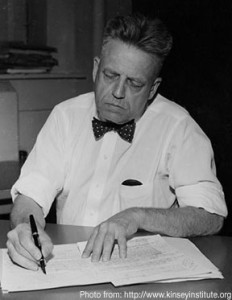Who is this fella, Kinsey?
 And so, twenty five years go by, and LGBT folk are still concealing their sexual orientations in terror of prosecution and public embarrassment; and out of the blue, a gentleman named, Alfred Kinsey, arrives and releases a book called, “Sexual Behavior in the Human Male.”
And so, twenty five years go by, and LGBT folk are still concealing their sexual orientations in terror of prosecution and public embarrassment; and out of the blue, a gentleman named, Alfred Kinsey, arrives and releases a book called, “Sexual Behavior in the Human Male.”
Kinsey’s monument study stands to this day as the most extensive and the most important review of human sexuality; this publication also informed the general public in layperson’s terms that homosexuality is much more common than what most people believed.
Do nearly half of all people in the human gene pool have homoerotic thoughts?
According to Kinsey, society was tagging individuals “homosexual” to defame them and to manage their conduct. He frequently criticized the tactic of labeling LGBT individuals, given that his own analysis of sexual behavior verified that almost forty percent of the total population “has at least some overt homosexual experience to the point of orgasm between adolescence and old age.”.
The American people largely approved of Kinsey’s groundwork, and individual perspectives towards intimate behavior began to discreetly evolve into a liberal trajectory. The very first birth control pillsbegan to hit the marketplace, and LBGT hate crimes were on the decline for the first time in American history.
Kinsey’s open dialogue on sexuality during the 50s brought about the sexual revolution in the following decade, where social morals that limited sex to heterosexual relationships were weakened, which set the course for the LGBT civil liberties to take off.
“The only unnatural sex act is that which you cannot perform.”
–Alfred Kinsey, 1952.
California always seems to play significant roles in LGBT Civil Right Movements.
The official launch of the LBGT civil liberties movement can possibly be traced back to a couple of organizations, which succeeded in surviving a lot longer than Chicago’s SHR club did.
On one of those chilly Seattle summer mornings, Phyllis Lyon met Del Martin. Both women were openly gay innovators in their communities who elected to mingle with other lesbian couples to talk about LBGT problems in the San Francisco Bay Area.
Not long after, the Daughters of Bilitis (DOB) society materialized, with the establishment’s title sufficiently adequate for public concealment, and, simultaneously, ample enough for lesbians to recognize. DOB was most renowned for managing pubic assemblies on homosexuality and providing counseling to lesbian partners in the soon-to-be-famous Castro District in San Francisco.
Los Angeles also participated in LGBT advocacy during the 50s, when Harry Hay and seven of his buddies embarked on path to reclassify the word “gay American.” The adult males called themselves The Mattachine Society, a French term that identifies folks who hide behind masks.
This southern California LGBT institution attempted to create an all-gay neighborhood, and the club motivated its constituents to stand up to any laws that restricted and reprimanded homosexuality. The Society also put on free municipal seminars to explain LGBT rights and established support systems for gay and lesbian women to examine their feelings. The Mattachine Society stayed alive well into the mid-80s before dividing into autonomous groups.
“To understand the lesbian as a sexual being, one must understand
woman as a sexual being.”
–Del Martin, 1958
